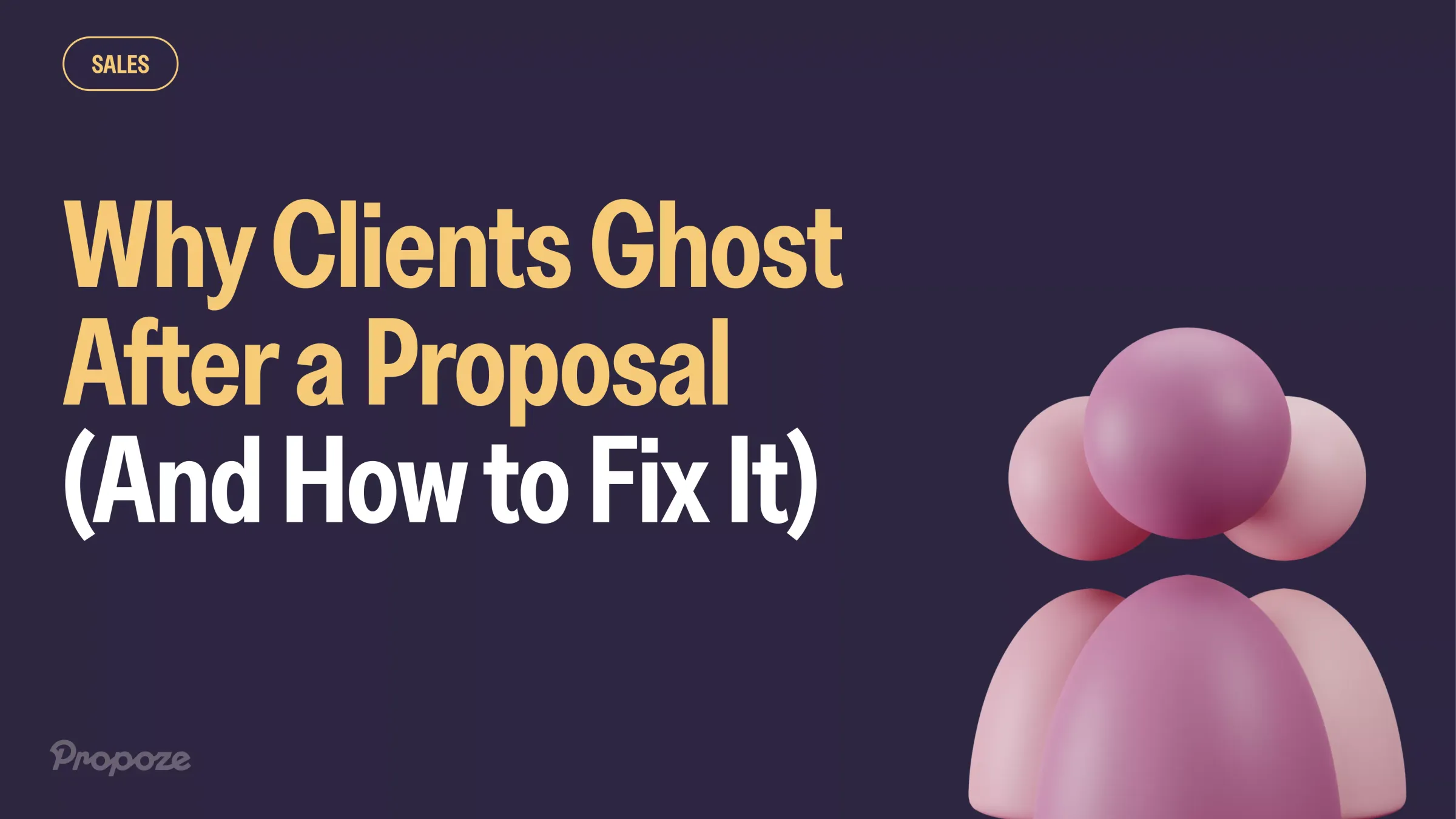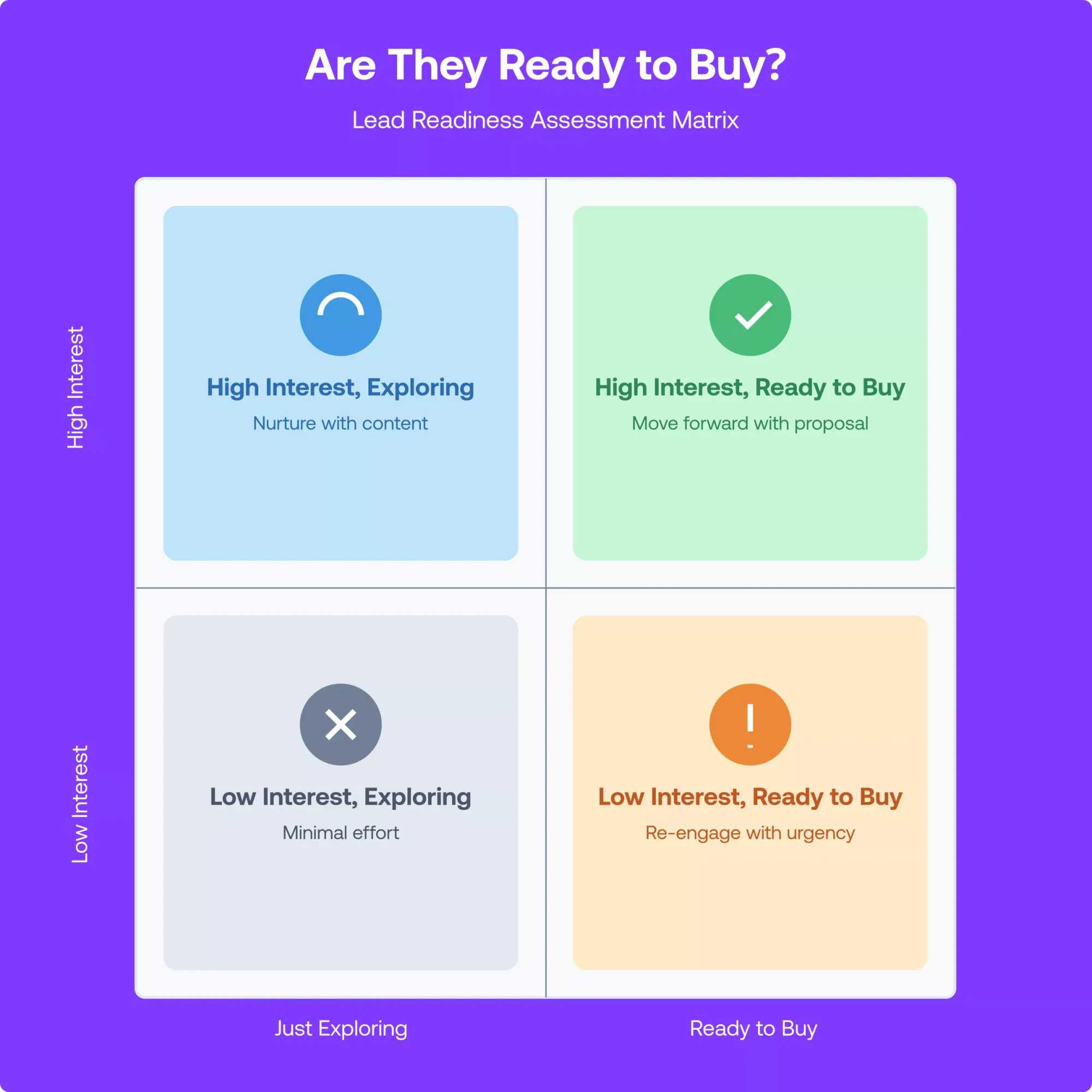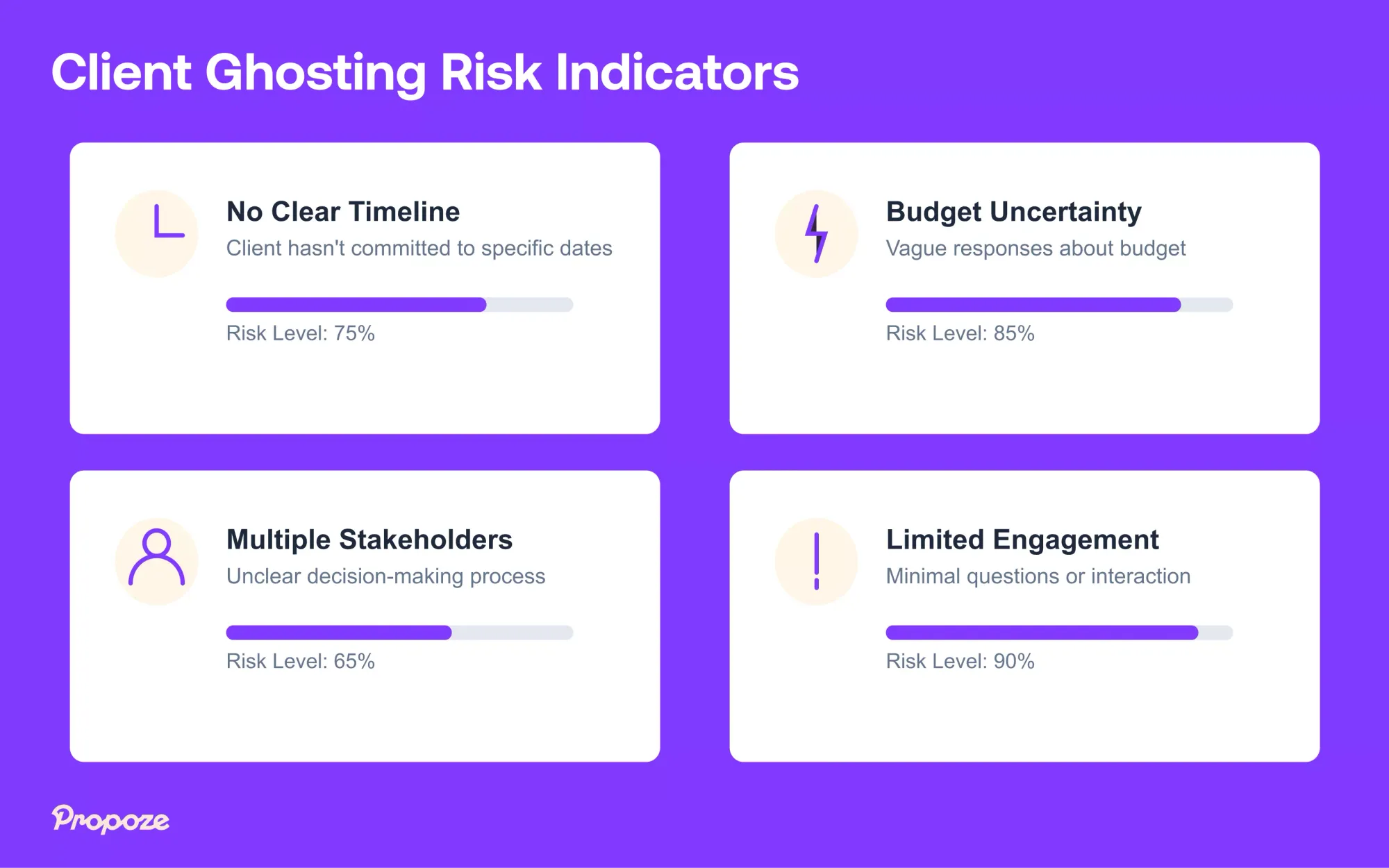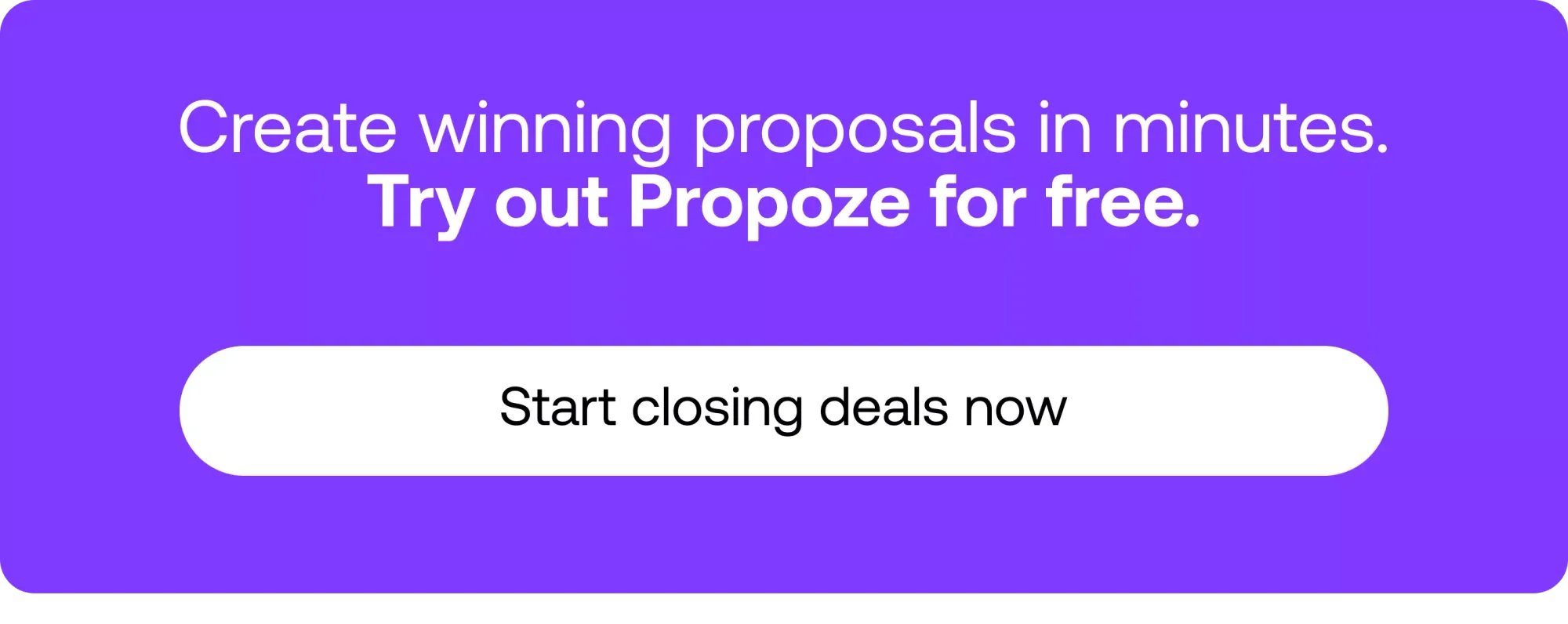What to Do When a Client Ghosts You (Handling Ghosted Leads)
Clients disappearing after you send a proposal? It’s not always about your offer — learn why prospects ghost and how to turn silence into signed deals.
— Propoze

You put in the work, craft a solid proposal, hit send… and then? Silence. No response. No feedback. Just radio silence.
It is frustrating to be left wondering, what to do when a client ghosts you. A ghosted lead can feel like the deal is dead, but that is not always the case.
The real issue might not be your proposal — it could be that your prospect wasn’t ready, got stuck in decision paralysis, or simply lost interest.
Client ghosting happens when prospects aren’t ready or engaged enough to make a decision. To solve this, focus on improving your client communication, set clear expectations, and use strategic follow-ups.
In this post, we’ll break down what to do when a client ghosts you, and how to avoid it. Let’s turn those disappearing acts into signed deals.
Understanding client ghosting: why it happens
Client ghosting can occur for several reasons. Maybe they weren’t ready to make a decision, had a shift in priorities, or were just gathering information.
Knowing why a ghost client goes silent helps refine your approach and prevent future issues like client ghosting payment problems. Here’s why clients might stop responding:
- They weren’t ready to buy – They may not have the budget or decision-making power.
- They were gathering information – Some prospects ask for proposals with no intention to proceed.
- Priorities shifted – Budget changes or new decision-makers might stall your proposal.
- Aggressive follow-ups – Too much pressure can push clients away.
This problem isn’t always personal, but understanding why it happens can help you refine your approach and reduce the chances of it happening again.
The real question: Were they ever ready to buy?
One of the biggest reasons clients ghost? They were never truly ready to buy.
Interest doesn’t always mean intent. Some prospects are just exploring, gathering information, or testing the waters — without a clear budget, approval, or urgency to move forward.
That doesn’t mean your proposal wasn’t good enough. It just might not have been the right time.
✅ Do they have a budget?
✅ Is there a timeline for a decision?
✅ Are you talking to the real decision-maker?
Qualifying leads early saves you time and ensures you’re putting effort into deals that have a real shot at closing.
When "helping" turns into free consulting
Sharing insights can build trust — but if you’re not careful, it can also turn into unpaid work. Some prospects request proposals just to collect free advice, never intending to move forward.
How do you avoid this? Set clear boundaries.
✔️ Offer strategic guidance, not full-blown solutions, during early conversations.
✔️ Position detailed insights as part of a paid consultation or proposal.
✔️ Make sure your value is clear—your expertise isn’t a free resource.
Helping is great, but your time is valuable. Protect it.

Why clients shift priorities (and how to keep up)
Even the most interested clients can go silent when priorities change.
1️⃣ Internal shake-ups. Budget cuts, staff turnover, or shifting business goals can put your proposal on hold.
2️⃣ New urgencies. A more pressing issue might take priority over the problem your solution solves.
3️⃣ Decision-maker switch-ups. A new stakeholder might come in with a different vision — or a different preferred vendor.
Things change, and that’s out of your control. What is in your control? Staying flexible, keeping communication open, and making it easy for clients to loop you back in when the timing is right.

How to Prevent Being Ghosted (Set the Right Expectations Early)
To avoid clients ghosting you, set clear expectations from the start. Here’s how to keep client communication strong:
- Qualify the lead. Ask key questions about their budget, timeline, and decision-making process to avoid wasting time on unqualified prospects.
- Clarify the decision-making process. Confirm who is involved and the decision timeline before sending the proposal. This reduces the chances of ghosting and payment issues later.
- Build trust early. Provide value through strategic conversations, case studies, or insights before the proposal stage. Clients prefer to work with those they trust.
- Follow up the right way. Skip generic “checking in” emails. Instead, send a friendly reminder with added value to reinforce the relationship.
A solid sales process doesn’t just get the proposal in front of the client—it keeps the conversation going until the deal is signed.
Qualify smarter: Stop chasing the wrong prospects
Want to avoid getting ghosted? Start by making sure you’re talking to the right people. If a prospect isn’t serious, you’re just wasting time. Here’s how to qualify effectively:
✔️ Ask the right questions. Do they have a budget? A timeline? A real need for your solution?
✔️ Gauge their urgency. Are they actively looking for a fix, or just exploring options?
✔️ Find the decision-maker. If you’re pitching to someone who can’t sign off, you’re already at a dead end.
The sooner you weed out bad-fit leads, the more time you’ll have for prospects who are actually ready to move forward.
Avoid surprises: The pre-proposal talk that prevents ghosting
Before you hit send on that proposal, make sure you and your client are on the same page. A quick conversation upfront can save you from radio silence later.
Here’s what to clarify:
✔️ Timeline: When do they expect the proposal? When will they make a decision? When should you follow up?
✔️ Budget: Are they comfortable with the cost? Do they actually have the budget to move forward?
✔️ Decision Process: Who needs to approve this? What steps are involved in getting a yes?
Getting clear answers now = fewer disappearing acts later. No guessing. No awkward follow-ups. Just a smoother path to a signed deal.

How to Deal with Clients Who Ghost You (Improving Client Communication)
Client gone silent? A ghosted lead doesn’t always mean the end.
Good communication can bring the lead back to life and rebuild the relationship. Here’s how to re-engage without sounding desperate:
1️⃣ Reassess Your Proposal — Take a step back. Was your pricing unclear? Did you miss a key concern? Make sure your offer aligns with their needs before following up.
2️⃣ Send a Friendly Nudge — Skip the generic “Just checking in” email. Instead, keep it light and helpful—ask if they need more details or if anything is holding them back.
3️⃣ Add Value, Not Pressure — Share something useful: a case study, a relevant insight, or a quick tip. Show them you’re thinking about their success, not just the sale.
4️⃣ Know When to Walk Away — If there’s still no response, don’t keep chasing. Let them know you’re available when they’re ready and move on.
The goal isn’t to force a response. It’s to remind them why working with you is worth their time. If they’re the right client, they’ll come back.
Before you follow up, check your proposal
If a client ghosts you, your proposal might have played a role. Take a step back and ask yourself:
✔️ Is it clear and concise? Did you spell out the problem, solution, and benefits in a way that’s easy to digest? A confusing or bloated proposal can lose their interest fast.
✔️ Does it align with their needs? If it doesn’t directly solve their problem or speak to their goals, they won’t feel the urgency to move forward.
✔️ Is the pricing transparent? Unclear costs or hidden fees create hesitation. Make sure your pricing is upfront, justified, and easy to understand.
A strong proposal shouldn’t just ask for a deal—it should make saying yes the easiest choice. If yours isn’t doing that, tweak it before following up.
How to Re-engage a Ghost Client (Without Being Desperate)
If a client has gone quiet, the right follow-up can put you back on their radar — without feeling pushy. Here’s how to do it right:
✔️ Keep it casual. No pressure, no desperation. A light, friendly tone makes it easier for them to re-engage.
✔️ Remind them of the value. Don’t rehash the entire proposal — just highlight a key benefit that solves their problem.
✔️ Ask for feedback, not a decision. Instead of "Are you ready to move forward?" try "Would love to hear your thoughts—anything I can clarify?"
✔️ Set expectations. Give them space to respond, but let them know when you'll follow up again.
A thoughtful, well-timed nudge can bring them back into the conversation—without making it awkward.
How companies turn ghosted leads into revenue
Ghosting doesn’t always mean the deal is dead—sometimes, the right follow-up can bring it back to life. Here’s a real-world example of how persistence and strategy turned silence into serious revenue.
HubSpot: A $100K deal from a ghosted prospect
HubSpot, a leader in inbound marketing, once had a promising prospect go completely silent after receiving a proposal. Instead of giving up, their sales team took a different approach:
✅ They personalized the follow-up. Instead of a generic “checking in” email, they sent a tailored message with additional insights specific to the client’s business.
✅ They offered more value. Rather than pushing for a decision, they provided a free consultation to refine the proposal based on updated needs.
✅ They stayed patient. Instead of bombarding the prospect with follow-ups, they focused on strategic, well-timed outreach.
The result? The conversation reopened, the proposal was adjusted, and the client signed a deal worth over $100,000 — weeks after going dark.
Persistence pays off. If a prospect ghosts you, the right mix of patience, personalization, and added value can bring them back.
How a SaaS company won back a $50k client after ghosting
Ghosted prospects aren’t always a lost cause — sometimes, a smarter follow-up can bring them back. That’s exactly what happened when Close, a SaaS CRM company, recovered a $50,000 deal after weeks of silence.
A mid-sized sales team was initially interested in Close’s CRM, but after receiving the proposal, they went quiet. Instead of spamming them with "Just following up" emails, Close took a more strategic approach.
The Solution:
✅ They reassessed the client’s concerns. After reviewing past conversations, they realized the client was hesitant about the complexity of implementation.
✅ They sent a value-driven follow-up. Instead of pushing for a response, they shared a case study showing how a similar company onboarded in under 30 days—addressing the exact concern that caused hesitation.
✅ They created urgency. Close informed the client about an upcoming price change, giving them a clear reason to act now.
Within two weeks, the client re-engaged and signed a $50,000 annual contract.
How a marketing agency turned ghosted leads into long-term clients
Ghosting isn’t always the end of the road—sometimes, it’s just a sign that a prospect needs more time. Directive Consulting, a B2B SaaS marketing agency, faced this challenge firsthand. Potential clients would engage in sales calls, request proposals, then vanish.
Instead of giving up, they built a lead nurturing strategy that transformed ghosted leads into loyal, long-term clients.
The Solution:
✅ They replaced “Just following up” emails with value. Instead of chasing prospects, they sent educational content—SEO case studies, performance reports, and industry insights that kept prospects engaged.
✅ They used retargeting ads. Ghosted prospects started seeing LinkedIn and Google ads tailored specifically to them, reinforcing brand awareness and keeping Directive top-of-mind.
✅ They personalized their re-engagement. Instead of pushing for a response, they sent a "Let’s Reconnect" email offering a free audit or consultation — making it easy for clients to re-engage when they were ready.
This approach helped Directive win back multiple ghosted prospects and convert them into high-value, long-term clients.
A ghosted lead isn’t necessarily a lost lead. By offering value, staying visible, and making it easy to re-engage, you can turn silent prospects into paying customers.
Turn a Ghosted Lead into a Signed Deal
Getting ghosted doesn’t mean the deal is dead—it means there’s room to improve your process.
✅ Qualify leads early so you’re not wasting time on the wrong prospects.
✅ Set clear expectations before you send a proposal.
✅ Follow up with value instead of just “checking in.”
The key? Stay proactive. Fine-tune your proposals, rethink your follow-ups, and always leave the door open for future conversations.
Tired of chasing silent prospects? It’s time to shift your strategy. Take control, engage smarter, and close more deals.
Need a better way to send and track proposals? Check out Propoze — so you never lose a deal to ghosting again.